Desperately seeking Isabel

"Do you know what's happening at Santa María?", she shouts. She sprints toward me, fast as a woman who looks to be well in her 70s can. She's breathless. Panicked. "They rang the bell. But they rang the small bell! And I don't know what that means!"
I make my usual mistake, explaining I don't know what the small bell means either, before I finally get to the punchline: I've been in Madrigal all of 10 minutes.
-You're not from here! Well, how are you going to know!
I'm not, I shrug. She tells me there's a large tour group I might want to join up at Saint Nicolas, and we wish each other a good day.
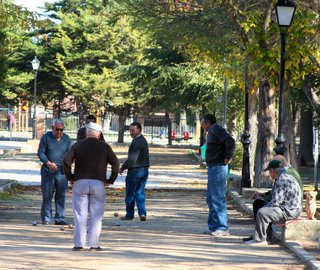 I've finally figured out why I love to visit pueblos in Spain. Pueblos, the smaller the better. Yes, they're often lovely. And historic. Yes, I often eat well in pueblos.
I've finally figured out why I love to visit pueblos in Spain. Pueblos, the smaller the better. Yes, they're often lovely. And historic. Yes, I often eat well in pueblos.But I've finally named it, after Saturday's visit to Madrigal de las Altas Torres, population 1,920.
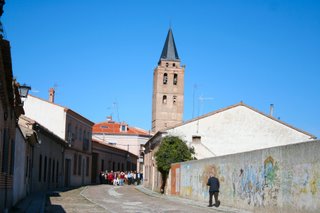
It's the welcome. I never feel like a stranger in a Spanish pueblo. Odd, isn't it? Where am I more of a stranger? Yet, speaking the language, looking like a woman, not necessarily an extranjera, I find myself fantasizing I live in every pueblo I visit.
It's the welcome: the nods, the Buenos Días and Buenas Tardes. The "Ponte más arriba si esperas el Auto-Res; para allí. ¡Hasta lo!". Not a person I passed in Madrigal let me by without a spoken hello. I spun round, stunned, when a teenager on a passing bicycle offered a hearty "Hasta Luego". Thirty seconds late, I called back, hoping he'd at least catch an echoed "uego" bouncing up the stone lined street behind him.
 I went to Madrigal in search of Isabel la Católica, and found the font where she was baptised. I missed her birthplace, a royal residence turned monastery that keeps admirable Spanish hours - a 12:30-4 pm closure for lunch. I found Vasco de Quiroga, a native son who founded a Utopian society amongst the indigenous people of Michoacan. And his nephew, Gaspar, a cardinal, the general inquisitor who threw out the heresy charges against Salamanca's lyric poet, Fray Luis de León.
I went to Madrigal in search of Isabel la Católica, and found the font where she was baptised. I missed her birthplace, a royal residence turned monastery that keeps admirable Spanish hours - a 12:30-4 pm closure for lunch. I found Vasco de Quiroga, a native son who founded a Utopian society amongst the indigenous people of Michoacan. And his nephew, Gaspar, a cardinal, the general inquisitor who threw out the heresy charges against Salamanca's lyric poet, Fray Luis de León. 
I found El Tostado, the theologian for whom Salamanca's own Calle Tostado was christened. And I found Fray Luis himself, who died in the Augustinian monastery that now lies crumbling in a field outside the city's 11th century walls.
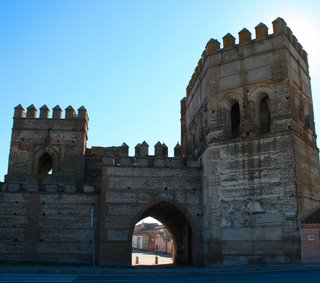 The grand entrance to the city lies south, along the highway to Madrid. A noble puerta, and one of the more than 80 towers in the originally Arab-built walls that surrounded the city. The town boasts two churches: San Nicolas (the slate-topped tower you see in the first photo, Avila's tallest mudéjar tower) and the 12th century Santa Maria del Castillo.
The grand entrance to the city lies south, along the highway to Madrid. A noble puerta, and one of the more than 80 towers in the originally Arab-built walls that surrounded the city. The town boasts two churches: San Nicolas (the slate-topped tower you see in the first photo, Avila's tallest mudéjar tower) and the 12th century Santa Maria del Castillo.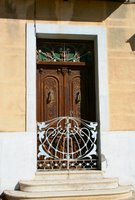 I'll be back in Madrigal. Next time, I'll call ahead. I'll leave time for the palace where Isabel was born, see if I can't arrange a look inside Santa María (hmmm...perhaps ask about that mysterious small bell?) and track down the museum of Vasco de Quiroga, housed in the 15th century Real Hospital de la Purísma Concepción. The tourism office, a table in the city library, is also housed in the Real Hospital. Saturday the tourism office consisted of a busy librarian and a stack of town maps. I'll take my new history consultant's advice, I think, and "get someone to show me around".
I'll be back in Madrigal. Next time, I'll call ahead. I'll leave time for the palace where Isabel was born, see if I can't arrange a look inside Santa María (hmmm...perhaps ask about that mysterious small bell?) and track down the museum of Vasco de Quiroga, housed in the 15th century Real Hospital de la Purísma Concepción. The tourism office, a table in the city library, is also housed in the Real Hospital. Saturday the tourism office consisted of a busy librarian and a stack of town maps. I'll take my new history consultant's advice, I think, and "get someone to show me around".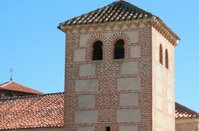 As for eating well, I did - solomillo equal to that of the superwedding, although I immediately caught my own ordering mistake. On the plains of Castilla, it's cochinillo (roasted suckling pig), or at the very least, lamb.
As for eating well, I did - solomillo equal to that of the superwedding, although I immediately caught my own ordering mistake. On the plains of Castilla, it's cochinillo (roasted suckling pig), or at the very least, lamb.Labels: wanders and travels







7 Comments:
I really enjoyed the trip too!
What a feeling! To belong!
By Cream, at 12:46 PM
Cream, at 12:46 PM
Haha, it was a good trip, wasn't it, cream?
By Erin, at 3:19 PM
Erin, at 3:19 PM
You describe the feeling of welcome very well that I also experienced in Spanish pueblos - I couldn't believe that someone fixing his roof, working on a road, or driving by would stop for 15 minutes just to chat!
By Mark K, at 8:21 AM
Mark K, at 8:21 AM
If you're not careful you'll be in danger of challenging that famous London Travel Blog
"http://diamondgeezer.blogspot.com/". You're already ahead on exciting destinations and photos ( in my opinion)and he never mets any interesting people on buses.
All that I can see that he has over you so far is a deal with Time Out magazine ( of london of course).
By Anonymous, at 6:40 PM
Anonymous, at 6:40 PM
La Reina Isabel la Católica debía ser declarada Santa, por sus humanitarias Leyes de Indias.........
By Anonymous, at 10:48 AM
Anonymous, at 10:48 AM
Erin, where have you gone? Getting withdrawn stuff.
By Anonymous, at 12:23 PM
Anonymous, at 12:23 PM
Thanks Daniel! for the compliment I'll check out diamond geezer) and for coming back to check on me.
I'm in the States for Thanksgiving, staying at my mom's, with dial up. I'm having a great time visiting and an awful time getting online. Seems my mother likes to use her telephone..and why I can't get my laptop to recognize any wireless signals at the local cafe I can't say....You think you're experiencing withdrawal!! I hope to post later today...
Anonymous, I can't say I agree with you, but I won't erase you, even if you're the anon leaving irrelevant comments all over my site. Isabel is an interesting historical character, and I bet if you visited my country you'd check out some historical characters I wouldn't want to canonize. Now Vasco de Quiroga, who I also mention in the post...there we get a little closer to admirable in a saintly way, don't we?
By Erin, at 3:42 PM
Erin, at 3:42 PM
Post a Comment
<< Home